Key West - In search of the islands in the stream…
Destination - AtlanticKey West, the most southerly point of the American mainland has always held a fascination for seafarers. Our journalist Kevin Green takes us out aboard a Seawind 1260, following in the wake of the island’s most famous resident, Ernest Hemingway.
Key West, at just 90 miles north of Cuba, daring to jut out into the might of the Gulf Stream, is the perfect setting for an end of the world story, or the beginning of another for sailors bound south through the emblematic “islands in the stream”, as Hemingway called them. The famous American author, winner of the Nobel Prize for Literature in 1954, actually lived in Key West from 1927 through 1939. And it was here that he penned some of his most famous works, including Green Hills of Africa, To Have and Have Not, and For Whom the Bell Tolls. Sailing south-west from Miami along the glistening 125-mile chain of islands that make up the Florida Keys is a fascinating voyage in this region of shifting sandbanks and storm-pummeled beaches where few monuments to men outlast the hurricane season. The storm season generally runs from June until November. In August 2019, Hurricane Dorian - destroyed much of the northern Bahamas with 185 mph winds.
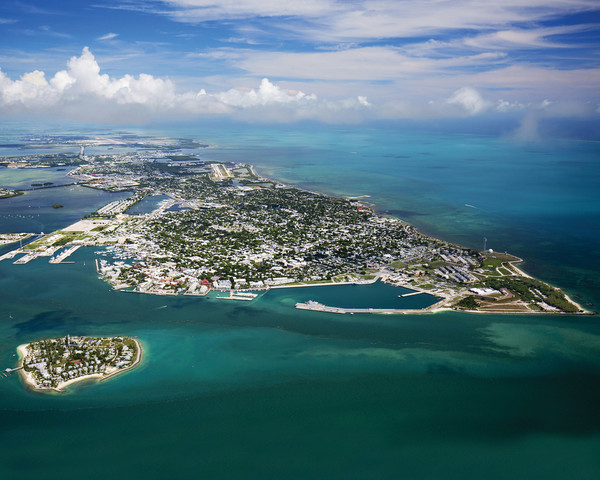
Located at 24° 33’ 35’’ N, 81° 47’ 01’’ W, Key West sits just above the Tropic of Cancer and enjoys a privileged climate – outside of hurricane season…
LATINO MIAMI
Getting intimate with the Keys and the nearby Bahamas is best done on a shoal draft boat, or a lifting keeler, though the ideal boat of course is a multihull, as I did recently on a new Seawind 1260 catamaran from Sailaway Charters. The route is the southern end of the 3,000-mile Intracoastal Waterway (ICW) that takes boaters safely south from Boston in north eastern USA. The shallow yet beautiful coral-strewn Bahamas are the most popular cruising ground for those sailors departing Miami, a mere 115 miles south-east. The city of Miami at the southern end of Florida is the gateway to the Keys and a fascinating city, often referred to as the ‘capital of Latin America’ because of its dominant Cuban and Caribbean demography. Arguably, the best rum in the world can be found here, with my favorites being pungent and slightly sweet Guatemalan and Venezuelan varieties, that are served by friendly expatriate Cubans. One of America’s most recent cities, as the entire region was a Spanish colony until the 1820s, Miami is pinned to the coast by the surrounding swamps of the Everglades to the west and the Gulf of Mexico to the south. As a major cruise ship port, its vast harbor throbs with large vessels and a busy container quay. Marinas for recreational craft abound as well, including the one on the island of Key Biscayne where I boarded our charter boat. Crandon Park marina charges my friends on a 35 footer, US$ 79 per night for casual marina berthing but the cheaper option is to use the swinging mooring in its sheltered bay then take an Uber across the causeway to downtown Miami for shopping.
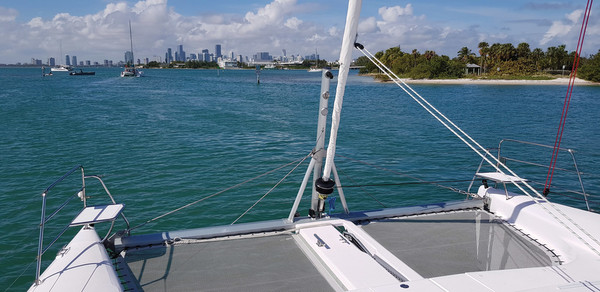
Located at 24° 33’ 35’’ N, 81° 47’ 01’’ W, Key West sits just above the Tropic of Cancer and enjoys a privileged climate – outside of hurricane season…
SHOAL DEPTHS
After visiting Miami to attend the three major boat shows that run simultaneously in February, we departed Crandon Park Marina on Key Biscayne to sail through the sparkling waters that lap against down-town Miami. Sheltered from the Atlantic seaboard by the sister city of Miami Beach, the area is reminiscent of where I keep my own boat, Sydney Harbour. But whereas we enjoy deep water, this American bay does not, so the marked channel south had to be followed religiously during our departure. With full sail our Seawind sped south into the Florida Straits, using the B&G plotter to guide us along the relatively shallow 50-foot (15m) contour which minimizes the impact of the north flowing Gulf Stream. Around us the low-lying islands hid behind mangroves which petered out at the shores of the Cape Florida lighthouse where we began our 10-mile open water sail to the first of the Keys, at Elliot. To starboard were strange apparitions; houses elevated from the water, from a former eccentric community known as Stiltsville. Renowned as dens of illicit activities, hurricanes caused this unusual community to be abandoned, leaving a dangerous bunch of obstacles for night-time sailors like ourselves.
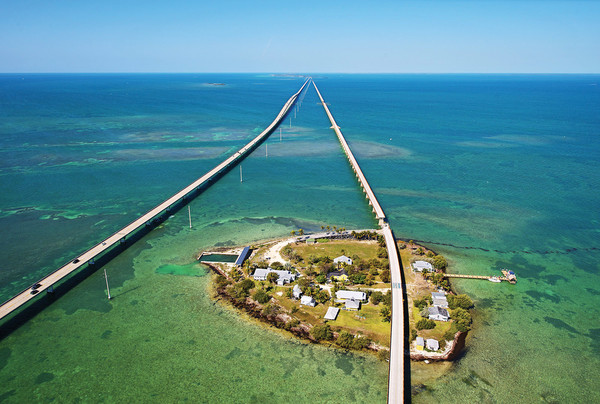
Driving the 120-mile (200 km) road and its 42 bridges is a unique experience.
BEAM REACH IN THE GULF STREAM!
Bowling along on a beam reach at eight knots reduced the stifling 86°F (30°C) heat thanks to the 15-knot wind pushing our new Seawind 1260 hard in the lumpy seas. At the helm where I sat on watch, my old friends the flying fish from the Gulf Stream skipped around me. Our Seawind crew were mostly from the company, delivering this new catamaran back into charter at Key West and they knew the region well, including skipper Shawn. The fleet of Seawinds includes the Australian builder’s latest model, the 1190 Sport, that was sailing in company with us and like all Sailaway boats is privately owned and put into charter. This allows owners to fly directly into Key West to explore this fascinating region of low-lying islands and pale blue waters. Our charts and pilot books show many features of the shallow warm waters, including wrecks of gold laden Spanish galleons and the various marine parks are a scuba diving Mecca. There’s even an enormous bronze statue of Jesus to dive on at Key Largo, named Christ of the Deep. “The diving is the main reason I spend the season down here in an RV park right on the water,” crewmate Charlie tells me over a beer. His lowlying RV parking spot is unlikely to survive a hurricane water surge but one blessing for mariners is the short tidal ranges of only a few feet (measured like the French do in Tidal Coefficients). The shallow waters allow easy anchoring, but marinas abound on the north-east side of the Keys. Passing Marathon Key, I watch the headlights along US1 highway as cars speed across the Seven Mile Bridge. Taking a car along the 42 road bridges and lush islands is one of the world’s iconic drives. Rest areas are mostly on the south going lanes, where you can stop to gaze at the mangrove strewn islands dotted with fishing shacks, small hamlets and watch powerboats zipping under the low lying bridges to fish Tarpon on the Gulf of Mexico.
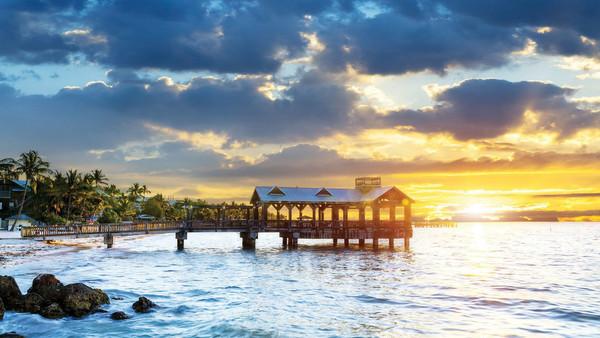
SUNSET IN THE KEYS
Aboard our Seawind, we snacked and toasted the sunset with only the occasional wave bouncing aboard as the Gulf Stream kicked up against the breeze. The B&G plotter screen was split to show an AIS overlay on the radar but there were few targets during my two hour 1am-3am watch. Just the sweet-scented breeze that smelt of mangroves and a star filled sky with few clouds. Below decks in the three double cabins, the rest of the crew slept soundly. Occasionally I tweaked the sheets as the wind backed but apart from that there was little to do except to enjoy the solitude of a night watch in tropical waters. As I drifted in reverie I imagined when Hemingway fishing these waters from his beloved boat Pilar. He’d come to Key West by chance and had fallen in love with the place. His grand house in town feels like he’d just left it but left before World War Two. Hemingway killed himself in 1961, before I was born, but remains a ghostly companion for those trying to write sparse prose about man’s relationship with the sea. As young man when I fished for a living to pay my undergraduate fees his words in books like The Old Man and the Sea felt visceral. Perhaps the older man in me grew to read these terse sentences in a harsher light, yet they remain poignant and never more so when sailing in his wake among these islands where he hunted the black marlin while wrestling with his equally black demons that would eventually kill him.
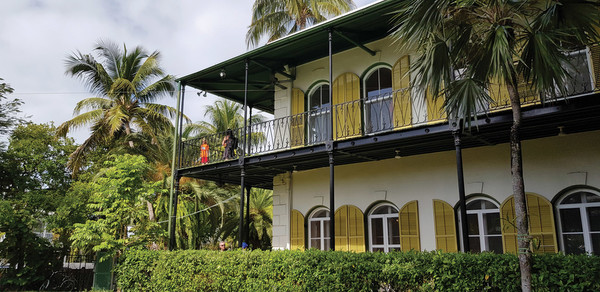
It was at this house in Key West where Hemingway wrote about the region in the novel To Have and Have Not. He lived here from 1931 to 1939 with his second wife Pauline Pfeiffer.
THE BARS OF KEY WEST: WATCH OUT FOR THAT HANGOVER!
La lumière du jour Daylight saw us passing one of the main boating centers and conurbations, Marathon Key, where we set our course closer to the coast. Few signs of man were showing now, apart from parts of the derelict railway bridge, which was the first overland way to the Keys in 1912. The Labor Day Hurricane of 1935 ended its short life, bankrupting builder Henry Flagler who then on-sold the route to the road builders to accommodate Henry Ford’s burgeoning creations. A few charter boats appeared out of the haze while high above Turkey Vultures circled ominously. The second last island in this chain, Stock Island, was our destination, next to Key West. We motored into the busy port to moor near the fleet of shrimp trawlers in searing hot sunshine, so we felt the need for cold beer at the convivial Hogfish Bar where many liveaboards milled around and plenty of friendly hellos were shouted to our seasoned crew. A riotous crew night in the many bars of Key West followed, with Hemingway’s bar Sloppy Joes given plenty of attention by us. Roosters chased us around the streets where picturesque clapboard houses rub against rum bars as Jimmy Buffett blared out. Leaning against the counters of some were Hemingway types, who mainly come for the annual lookalike competition in July. These grizzled chaps happily mix with clean-cut New Yorkers, freshly flown into the Key West airport. One bar sign helpfully advertised a hangover hospital in town, something I felt in need of the following day. Awakening in my comfy cabin was a painful experience, made worse by roosters squawking in my ears, so I sought refuge in the wonderful Maritime Museum. There, I discovered artefacts from the wreck of the Spanish galleon Atocha (1622) salvaged by Mel Fisher in 1985, including 40 tons of gold and silver bullion. The Netflix pirate series Black Sails features the story of this galleon, among other rollicking tales of high seas barbarism. Cuba was the hub for the Spanish colonists’ ships leaving South and Central America but navigating the major obstacle of the Keys often proved too much for them. Hunted by privateers, pirates and most deadly of all - hurricanes - many galleons prematurely ended their voyage below these clear blue waters. Today, things are safer. Often described as the best harbor south of Chesapeake Bay, the vast expanse of the Key West port is home to the US navy and the myriad of cruise ships that ply the archipelago - ideal charter territory for us lucky sailors.
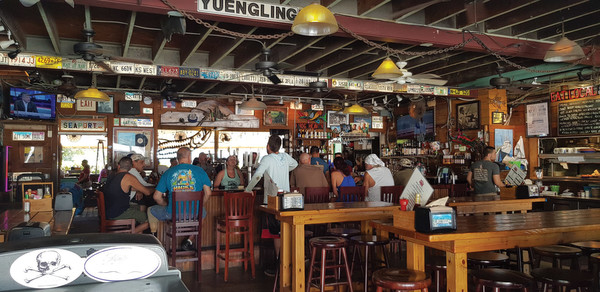
The Hogfish Bar Stock Island: this friendly bar served us tasty Hogfish and conch fritters with cold Yuengling beer.
KEY INFORMATION
Charts: Navionics or use free NOAA e-charts on OpenCPN
Pilotage: www.cruiserswiki.org/wiki/ Florida_State
Tourism: www.visitflorida.com
Marinas: www.marinas.com/browse/ marina/US/FL
Sailing Season: December to May ideally
Travel: Key West airport or 130-mile (200 km) drive from Miami
Power: 110 V
Charter: www.sailawaykw.com
Charter companies for this destination
Destinations offered by
View all the destinations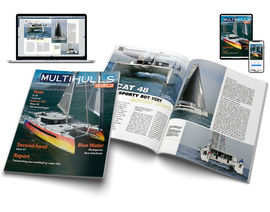
Subscribe and get 8 issues a yearfor just $39.90
subscribeClassified ads
View classified ads2020 Robertson and Caine Leopard 45 - La Filouterie
- Location :
- Raiatea, French Polynesia
 Discover the 2025 winners!
Discover the 2025 winners! 
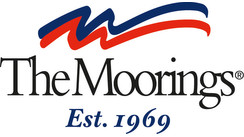
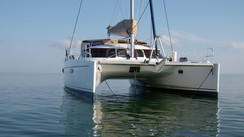
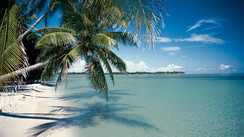
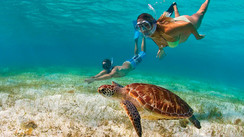
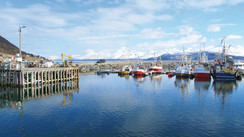
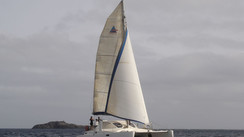
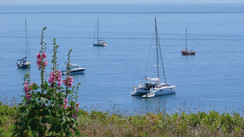





What readers think
Post a comment
No comments to show.